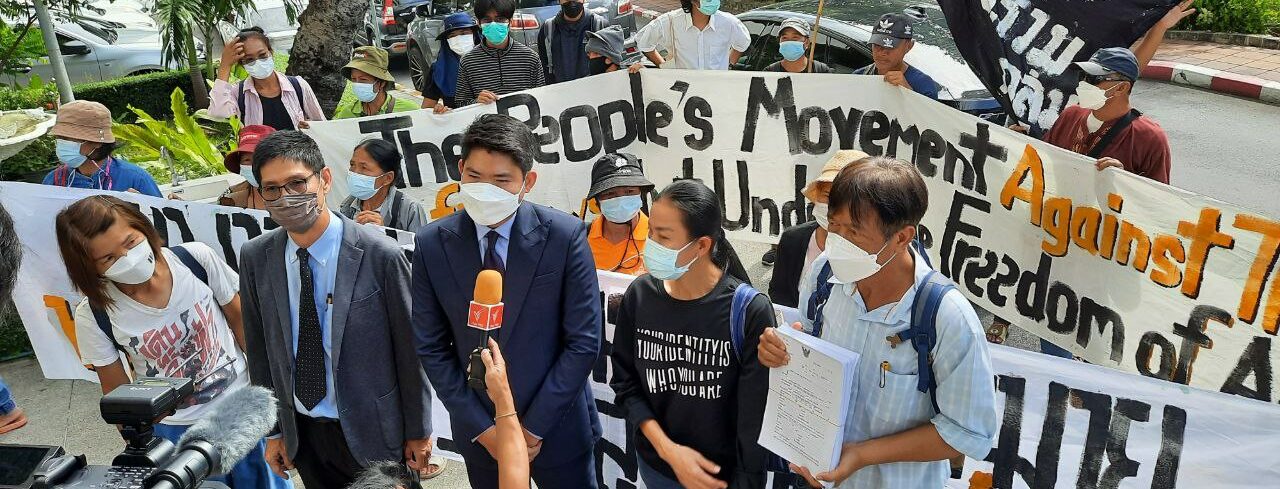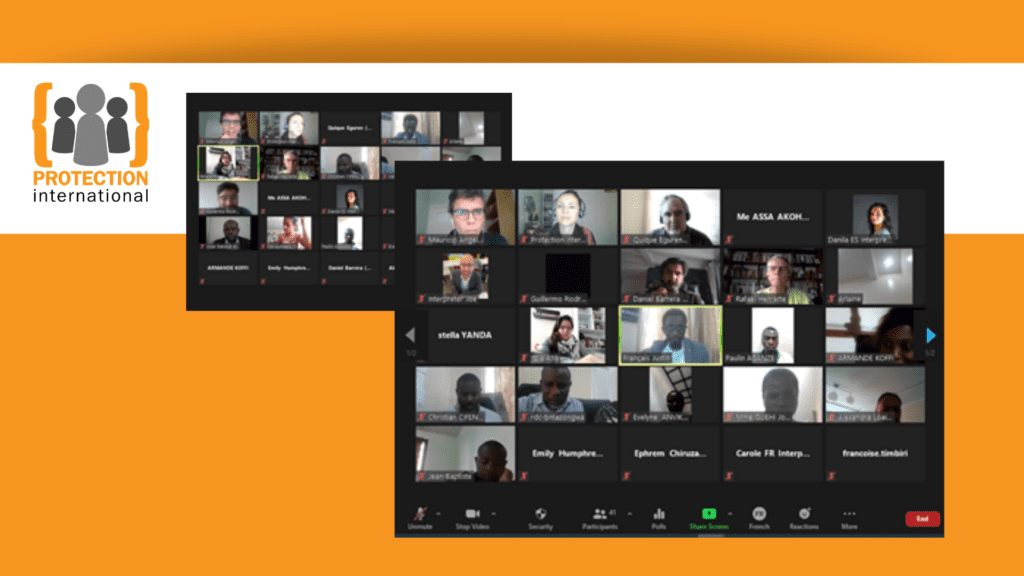Human rights defenders from Latin America and Africa share experiences related to public policies meant for their protection
On 21 January 2021, 44 human rights defenders met – virtually from their homes – to share their experiences about their country’s public protection policies. Participants included defenders from Colombia, Côte d’Ivoire, Honduras, Mexico, and the Democratic Republic of Congo (DR Congo).
This meeting made possible thanks to financial support from the European Union, is the second virtual encounter organized by Protection International and its partner in DR Congo, SOS Information Juridique Multisectorielle (SOS IJM), since the beginning of the pandemic.
The goal is to enable human rights defenders (W/HRDs) to critically and comparatively review existing public policies across the two regions, to further enable W/HRDs’ ability to carry out their right to defend human rights. Both regions are currently in alarming situations about the protection of human rights defenders, with tensions heightened due to the global pandemic.
Protracted political instability, endemic armed conflicts, and unbridled violence
From Colombia to the Democratic Republic of Congo, including Mexico and Côte d’Ivoire, human rights defenders are not only confronted with corruption, violence, and fragile democratic systems, but they often pay a heavy price for their work. Latin America and the Caribbean were the world’s deadliest regions for human rights defenders in 2020 – accounting for 79% of the 331 homicides worldwide according to Front Line Defenders’ most recent report (2020). Colombia, where 177 people lost their lives in the defence of human rights, continues to hold the unfortunate rank of the most dangerous country in the world for W/HRDs.
Despite intimidations, threats, arbitrary arrests, physical assaults, and killings of human rights defenders, civil society actors refuse to sit idly by. Through the exchanges between the two regions, it is clear that civil society organizations have played a key role in mobilizing, lobbying, and advocating with decision-makers for the adoption of a number of protection mechanisms and legal instruments by their governments.
The context for defenders in Latin America and Africa remains grim, but it is worth noting that, over the last two decades, both regions have seen important developments in national public policies for the protection of human rights defenders. Although effective implementation is often problematic, more countries now have mechanisms in place for the protection of W/HRDs – in the form of laws and other legal provisions at the national level.
Faltering protection mechanisms in Latin America
As exemplified by the earlier statistics, Latin America has a grave need for protection mechanisms. Colombia established a State protection mechanism in the late 1990s, due to the high levels of violence suffered by W/HRDs and social leaders due to the country’s internal armed conflict. Some States have enacted legislation for the specific protection of W/HRDs —including Mexico, which legally established a mechanism for defenders and journalists in 2012, and Honduras, which adopted a law protecting defenders in 2015.
While the existence of these mechanisms for W/HRDs is undoubtedly positive, their effective application of protection measures continues to stall. Despite the clear interest of some leaders in passing laws to protect defenders, the gap between rhetoric, promises, and implementation remains a major challenge.
“The lack of trust between State authorities and human rights defenders, as well as poor coordination, makes the existing protection mechanisms in Latin America ineffective,” says Guillermo Rodriguez, a staff member of the Centre for Justice and International Law (CEJIL) who participated in the virtual event. In Colombia, for example, there is a lack of coordination between civil society actors and the authorities when working to apply protection measures. In Mexico, there is a certain openness between the authorities and defenders to strengthen the protection mechanism, but systemic issues in the justice system continue to fail to abate perpetrators’ willingness to act.
“In Mexican legislation, attempts are being made to identify certain risk factors at the federal level in coordination with State authorities to reduce precisely those identified risks. This process is certainly important, but it should also be accompanied by protective measures to be more effective in repairing damage and avoiding impunity”, says Itzia Miravete, Prevention and Advocacy Coordinator for Mexico and Central America, of Article 19, an organization that is part of Espacio OSC, a civil society initiative that was created to monitor the functioning of the national protection mechanism.
Initiatives in Africa
In Africa, comparatively, to Latin America, the establishment of national public policies is a recent phenomenon. The United Nations and the African Union have positively influenced many countries to enact protection mechanisms and improve the situation of human rights. Nevertheless, the continent has continued to record an alarming number of human rights violations and abuses in many countries. In 2020, DR Congo alone recorded 7,909 cases of human rights violations and abuses according to the United Nations Joint Human Rights Office (UNJHRO).
Côte d’Ivoire adopted a law protecting human rights defenders in 2014. This law, which defines the roles, duties, and rights of W/HRDs, aims to guarantee them a protective environment in the exercise of their work. It also recognizes the major role played by defenders in the country’s development.
The Ivorian mechanism provides special protection to WHRDs against all forms of threats, violence, and discrimination related to their status as women, in accordance with international legal instruments on women’s rights.
“In Côte d’Ivoire’s context, civil society organizations have played a frontline role in raising awareness of the content of this law, but its actual implementation remains a challenge”, said Ms. Assa Simone, President of the Association of Women Lawyers of Côte d’Ivoire.
The sheer fact that Côte d’Ivoire has adopted a law for the protection of W/HRDs, however, has been a major inspiration for human rights defenders in the DR Congo. DR Congo is in the process of passing a law at the national level on the protection of W/HRDs; however, the proceedings remain in a deadlock. Since the DR Congo has a federal system, defenders and activists have been leaning on their constitutional right for provincial parliaments to pass protection laws. Principally, human rights defenders in North and South Kivu—two provinces in the east of the DR Congo—have made important progress in this regard.
Over the past five years, Congolese civil society organizations in the provinces of North and South Kivu have noticeably increased their advocacy activities with State institutions to push for the adoption of laws protecting W/HRDs. One of their major successes dates back to February 2016, when the Governor of South Kivu Province promulgated a provincial edict (or mandate) for the protection of W/HRDs and journalists. Three years later, W/HRDs in the neighboring province of North Kivu saw their efforts rewarded with the adoption of a similar provincial decree.
“The adoption of these two provincial edicts has offered a beacon of hope for the protection of human rights defenders in the east of the country, where the security situation makes the work of defenders difficult“, explained Gratias Kibanja, a lawyer and member of the Ukingo Wetu Synergy, a network for the protection of W/HRDs who participated in the development of the draft provincial edict of North Kivu. As in Côte d’Ivoire, this provincial law also devotes special protection to women human rights defenders in Article 6.
It is safe to say that these successes have generated momentum for defenders and their allies in other provinces. For example, a proposal for a provincial edict on the protection of WHRDs is currently under consideration by the Provincial Assembly in Sud-Ubangi.
In short: A comparison between Latin America and Africa
In Latin America, legislation has been the principal driver behind the creation of protection mechanisms and procedures for human rights defenders at risk. To get to this point, a diversity of civil society organizations worked closely to form networks and collectively advocate for enhanced protection. But for a variety of reasons—funding gaps, a lack of political will, long-running and internal conflicts, insufficient coordination between authorities and civil society, etc.—these mechanisms still need significant improvements before defenders can feel confident in a protection plan’s effective implementation.
In Africa, however, existing laws address abstract principles of rights and duties regarding protection without pointing to the creation of specific mechanisms. The mechanisms that have been created are obscure and do not clearly explain the necessary procedures for obtaining protection or assistance if human rights defenders are subject to threats. Since governments are the main duty-bearer for the protection of W/HRDs, authorities at all levels must take concrete actions—including public policies that adequately protect human rights defenders and grant them access to relevant information and assistance when their safety is in danger.
“While in Latin America the protection process is more based on providing physical security to W/HRDs at risk, in Africa it is more about rights in general, where existing laws are statements of good intentions. It is important that Africa has mechanisms or policies that can operationalize existing laws so that these laws are more effective“, concluded Quique Eguren, a public policy expert with Protection International’s global team. “This exchange was a very enriching exercise, which gave us a comparison of two very different contexts.”
This year, Protection International will launch a new initiative titled FOCUS: The Observatory on Public Policies for Defenders, which is an online platform aimed at monitoring, analyzing and promoting best practices in policy that governments and other State authorities adopt for protecting W/HRDs. This tool aims to further facilitate the development of protection standards and recommendations by regional and international bodies, as well as provide a resource for civil society to more easily make comparative references between existing legislation around the world. Nothing can replace, however, the person-to-person exchanges and knowledge-sharing initiatives between defenders, which is why we hope to continue participating in these virtual encounters. The critical reflections of W/HRDs in consideration of their lived experience can only benefit the creation of more effective public policy.


